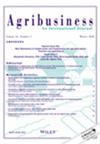水果业的产品差异化:商标苹果的启示
IF 2.1
3区 经济学
Q2 AGRICULTURAL ECONOMICS & POLICY
引用次数: 0
摘要
我们得出了专利或商标苹果品种(也称为 "俱乐部苹果")与开放品种苹果相比的溢价。我们利用广泛的零售扫描仪数据集以及苹果口味特征的独特数据,估算出 2008-2018 年每月的俱乐部苹果溢价。我们发现,俱乐部苹果的溢价率约为 29%,并从 2008 年的 35% 持续下降到 2018 年的 22%。积极的俱乐部苹果溢价与消费者偏好多汁、更酸和更甜的苹果有关。我们没有发现证据表明,消费者看重购买更昂贵、更有限品种的排他性。因此,俱乐部溢价在市场上的存在是为了满足消费者群体对具有独特口味属性的苹果的需求,而不是取代偏好开放品种的传统消费者的需求。我们采用向量误差修正框架来寻找俱乐部苹果溢价的短期和长期决定因素。在短期内,考虑到溢价和成本因素,俱乐部品种的销售可能与开放品种的销售正相关。然而,从长期来看,苹果俱乐部销售额、苹果开放品种销售额和苹果俱乐部溢价之间存在负协整关系;苹果俱乐部销售额的增加与苹果开放品种销售额和苹果俱乐部溢价呈负相关。受保护的俱乐部品种最初的高溢价激励了独特差异化苹果品种的发展,而从长期来看,随着生产的扩大,溢价会降低,使俱乐部品种对消费者来说更便宜[经济学引文:L66,Q11]。本文章由计算机程序翻译,如有差异,请以英文原文为准。
Product differentiation in the fruit industry: Lessons from trademarked apples
We derive price premiums for patented or trademarked apple varieties, also known as “club apples,” compared to open‐variety apples. We use an expansive retail scanner dataset, along with unique data on apple taste characteristics, to estimate monthly club apple premiums for 2008–2018. We find that club apple premiums are around 29% and have consistently decreased from 35% in 2008 to 22% in 2018. Positive club apple premiums relate to consumers' preferences for juicier, more acidic, and sweeter apples. We do not find evidence that consumers place value on the exclusivity of purchasing more expensive and limited varieties. Hence club premiums exist in the market by meeting the demand of consumer segments for apples with distinct taste attributes rather than replacing the demand of traditional consumers who prefer open varieties. We use a vector error correction framework to find short‐run and long‐run determinants of club apple premiums. In the short run, the sales of club varieties may positively associate with the sales of open varieties, given the premium and cost factors. However, in the long run, there is a negative cointegrated relationship between club apple sales, open apple sales, and club apple premiums; and an increase in club apple sales is adversely related to the open apple sales and club premiums. The high initial premiums of protected club varieties have provided incentives for the development of uniquely differentiated apple varieties, while in the long term as production expands, premiums decrease making club varieties less expensive for consumers [EconLit Citations: L66, Q11].
求助全文
通过发布文献求助,成功后即可免费获取论文全文。
去求助
来源期刊

Agribusiness
农林科学-食品科技
CiteScore
5.50
自引率
6.20%
发文量
58
审稿时长
6 months
期刊介绍:
Agribusiness: An International Journal publishes research that improves our understanding of how food systems work, how they are evolving, and how public and/or private actions affect the performance of the global agro-industrial complex. The journal focuses on the application of economic analysis to the organization and performance of firms and markets in industrial food systems. Subject matter areas include supply and demand analysis, industrial organization analysis, price and trade analysis, marketing, finance, and public policy analysis. International, cross-country comparative, and within-country studies are welcome. To facilitate research the journal’s Forum section, on an intermittent basis, offers commentary and reports on business policy issues.
 求助内容:
求助内容: 应助结果提醒方式:
应助结果提醒方式:


